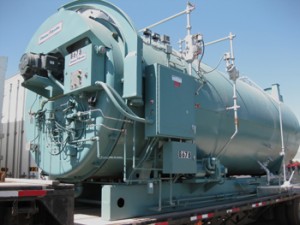No matter what type or size of boiler you are looking to purchase, there is always one question you must always answer when selecting a steam boiler: What is the basis for design? Fulton Company recently published a list of 10 features you wish every boiler had. It is important to review this list and be sure to know which attributes are most important to you and your specific application. In addition, when selecting the right boiler provider, remember that any qualified boiler company should be able to provide you with accurate boiler specifications, performance data, and drawings, all of which will make the decision process easier and will help you along the boiler decision process.
*** With emission requirements changing everyday, it is also important to make sure that you are proactive when selecting equipment that will comply with future air regulations. Nationwide Boiler has the most experience in selecting boiler equipment that will meet current and future NOx requirements and we developed the CataStak SCR system as a solution for ULN compliance. Contact Nationwide Boiler today to discuss the requirements of your new or used boiler systems. We will be happy to help. Toll free: 1-800-227-1966.
1. High Pressure Vessel Mass
The mass of the boiler will be a good indication of the amount of metal used to manufacture the pressure vessel. Mass is related to thickness and thickness is related to durability. Inherently, low mass boilers will not last as long as high mass boilers.
2. High Water Volume
Water under pressure will store steam. Higher water volume means higher stored steam. Applications where you have rapid swing loads will require a high water volume boiler design.
3. High Efficiency
We all would like to have the most efficient boiler. Efficiency, however, must be defined and compared on equal terms. Ensure boiler pressure, feed water temperature, firing rate, fuel BTU value and stack CO2 levels are all defined on the same playing field.
4. Quick Startup Times
Simply put, you want steam in a reasonable time frame. Boilers that can make steam quickly likely will have low water and low mass, which may be non-desirable features. One must also realize a quick startup will facilitate a quicker cool down. The boilers on the market today typically require 5 to 20 minutes startup time or more, depending on the size of the boiler
5. Low Footprint
Boiler room real estate is quite valuable these days and the less room a boiler occupies, the better. Be sure you take into consideration the amount of room required to perform maintenance on the boiler as part of the overall footprint.
6. Low Heat Flux and High Heating Surface Area
Heat transfer is represented by the equation
Q =m x Cp x ?T
where m is the heating surface area.
Most heating surface area listings are for the fire-side surface area, with higher fire-side surface area values indicating higher the heat transfer efficiency. However, one also must consider the wetted heating surface area. The wetted heating surface area determines heat flux. Consequently, low wetted heating surface area can have very high heat flux, which can create higher metal temperature and increase scaling potential.
Boilers with high fire-side and high wetted heating surface areas will be the most efficient and have low heat flux.
7. Ease of Clean Out
This is a measure of effectiveness of blow down and ability to keep the pressure vessel clean.
8. Effective Turndown
This feature has a lot to do with the burner performance. Effective turndown is a measure of how low the fuel input and air can be adjusted to maintain good combustion efficiency. Some burners will turn down the fuel but leave high excess air on low fire. This will create high turndown but poor overall combustion efficiency. Look at the highest turndown level while still maintaining good combustion efficiency.
9. Ease of Maintenance
Hardly ever will a specifying engineer think about maintenance when selecting a boiler. They should. Blow down valves, stack location, feed water inlet, control panel location, tube removal, burner removal and gas piping maintenance should all be considered as criteria of boiler selection.
10. Large Steam Disengagement Area
Like heating surface area, the more steam disengagement area, the better. Higher steam disengagement area produces higher steam quality, especially for low pressure steam applications. Consequently, horizontal boilers generally will produce higher steam quality than a vertical boiler of the same output.



